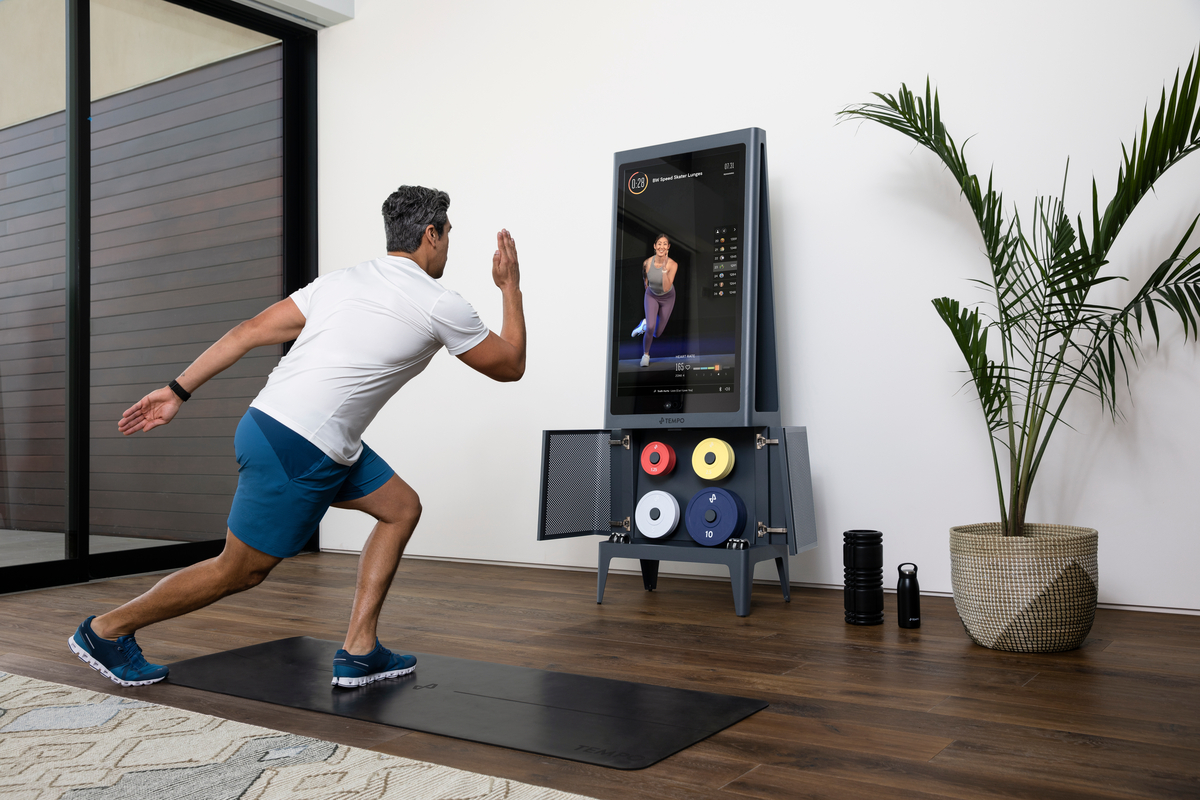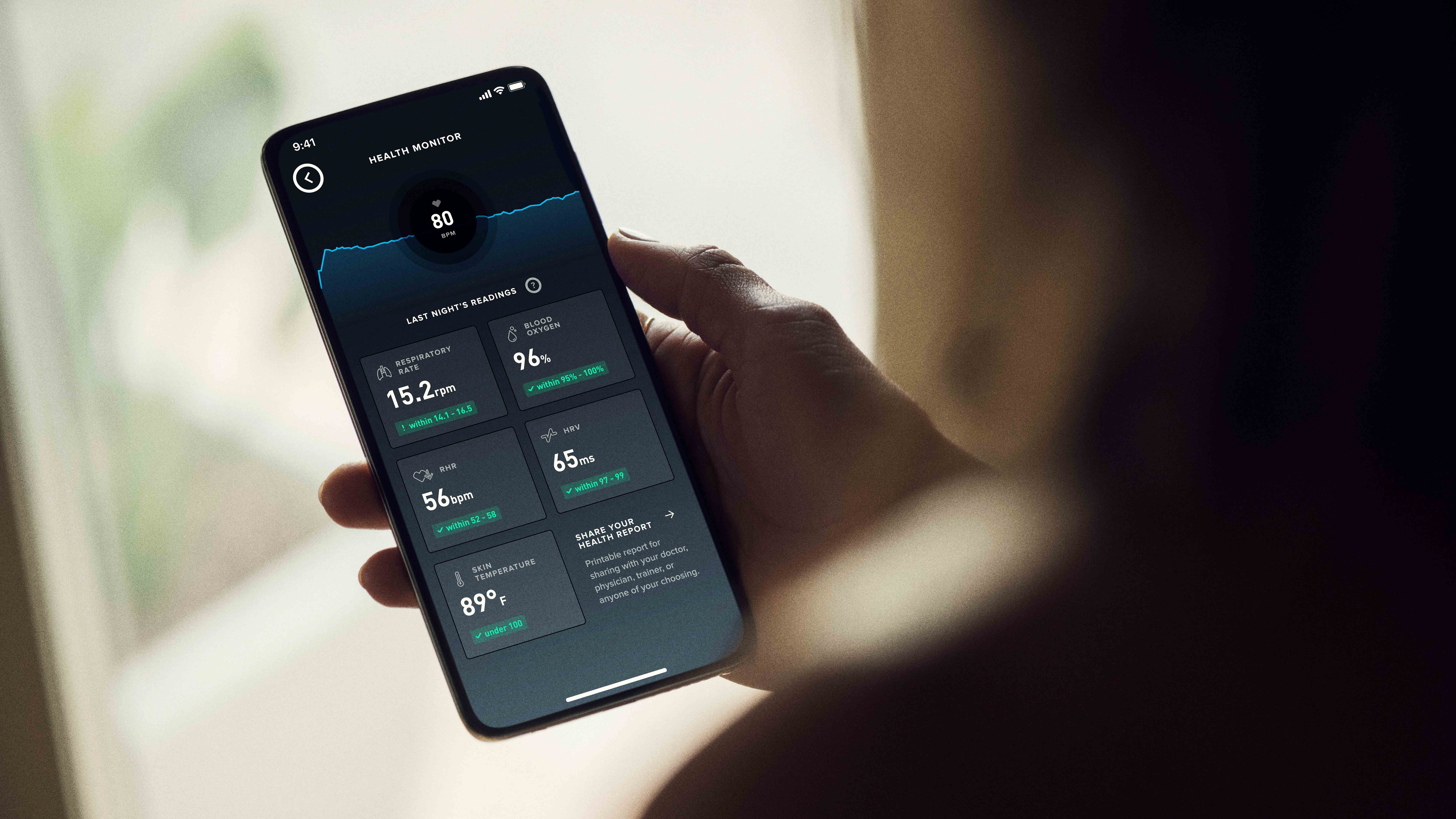Thanks to a smartwatch on your wrist, your fitness app already knows you skipped your workout today. But the AI behind it is already creating a personalized plan to get you back on track. That’s the reality of fitness AI in 2026: no guessing, no generic workouts, just algorithms that flex in real time to match the unique fitness journey of each individual.
So, let’s have a closer peek at the state of the AI fitness industry and how AI helps fitness enthusiasts reach their health goals.
The state of AI fitness technology
First, a quick temperature check, so we know for sure AI is living up to the hype.
- In 2024, the global AI in fitness and wellness market was valued at $9.8 billion and is projected to exceed $46 billion by 2034.
- Over 50% of people would use AI for personal training.
- Almost 1 in 5 U.S. consumers and 1 in 3 U.S. millennials prefer personalized products and services. Some are even willing to part with their biometric data in exchange for personalized recommendations.
- Heavyweights are banking on AI: Nike is busy developing its own large language model, while Apple’s secret AI-powered health coach is soon to revamp the existing Apple Health app and ecosystem. Сonnected fitness leader Echelon is teaming up with AWS to release a generative AI-powered fitness platform for hyper-personalized workouts.
Beyond the AI craze, fitness brands are doubling down on AI due to its strategic moat, as AI fitness technology is the only way to personalize fitness experiences at scale, deepen user engagement, and lead the pack in a fiercely competitive market.
How does artificial intelligence amp up fitness apps? 5 real-world applications
Machine learning, conversational AI, computer vision, and other forms of artificial intelligence stand behind the new era of fitness — precision fitness. It doesn’t stop at tracking; advanced AI helps fitness apps adapt in real-time and scale the kind of nuanced coaching that was previously confined to elite athletes.
Hyper-personalized and adaptive fitness plans
Unlike static workout routines, AI algorithms can leverage real-time data, including the user’s sleep quality, performance trends, energy levels, and other biometrics, to adjust and refine fitness plans on the go. For example, the app can reduce the intensity when the user’s HRV is high or pivot them to a restorative exercise after a rough nighttime sleep. Other examples of adaptive personalization in action include:
- Smart recovery protocols/recommendations based on predicted fatigue levels and real-time biometrics.
- Real-time workout recommendations that fine-tune the intensity, duration, or workout type to the user’s current profile.
- Dynamic goal setting that adjusts goals based on the user's progress.
- Behavioral adaptation that enables the system to respond to the user’s behavioral patterns.
- Tailored recovery-to-performance cycles that calibrate the intensity-volume-rest loop for maximum performance.
To adapt in real-time and act on real-life interruptions, an AI-powered fitness app has to work in tandem with wearables. The latter serves as the eyes and ears of the in-app AI and collects behavioral and biometric data that then becomes personalized workout plans.
Example: Zing Coach

Zing’s AI Coach checks in daily with the user’s sleep data, energy levels, mood, and other factors to recalibrate a workout plan in real time. Alongside lifestyle data, the app also builds upon the user’s conversation with the in-app chat to get a complete read on the user’s mental, emotional, and physical state.
Real-time motion analysis and form correction with AI
Geared up with computer vision, real-time motion analysis, and gait analysis, AI fitness apps can not only tell the user what to do but watch it do it and course-correct them in real-time. Whether through smartphones or AI-powered devices like mirrors and gym equipment, the system tracks joint positions, the range of motion, and alignment — all in real-time.
So far, this fitness technology has been popular in applications like:
- AI livestream workouts where AI analyzes users’ form during live classes and rewards them with fitness points redeemable for e-commerce discounts.
- Smart mirrors and AI-enabled home gyms (such as Amp or Tonal), which provide instant feedback during reps, like reminders to correct posture.
- Physical therapy apps that make sure users perform recovery exercises correctly and safely at home.
Example: Tempo

Tempo is a membership-based virtual training platform and smart home gym that utilizes 3D sensors, an HD screen, and AI-powered form tracking to guide customers through movement and mobility workouts. Using AI technology, the platform delivers real-time feedback on form, tempo, and posture. Additionally, periodic 3D body scans track the user's overall physique, including body fat, muscle mass, and other key metrics, to provide nuanced feedback on their progress and overall physical development.
AI-powered virtual coaching and conversational assistants
Whether users need a personal trainer, cheerleader, or rehabilitation specialist, the conversational AI inside fitness and wellness applications can now fill that role. Today’s AI fitness coaches are built on the back of large language models to hold fluid, empathetic, and dynamic conversations with users. So, the entire digital fitness experience feels human and as if an elite coach has got your back.
A conversational AI trainer may support the following interactions within fitness apps:
- On-demand fitness, wellness, or nutrition coaches that provide contextual guidance to the user based on their fitness data, health data, and other input.
- Mental health integration, where fitness AI coaches suggest mindfulness exercises when stress levels are up.
- “Motivation AI” for real-time encouragement linked to the user’s progress, fitness routine, or text/speech inputs during workouts and check-ins.
- Personalized habit-building support that nudges users toward drinking more water or squeezing in a short workout in their busy schedules.
- Multi-modal coaching that combines audio cues, video demonstrations, and live form feedback.
Example: Whoop

Whoop Coach builds on the Open AI technology, integrated with proprietary WHOOP AI, to churn out highly personalized, conversational responses to the user’s health, fitness, and wellness questions. The coach analyzes personal biometric data for patterns, like strain levels, sleep quality, HRV, and more, to provide personalized insights.
AI-powered nutrition and holistic wellness
Speaking about a truly 360-degree health experience beyond strength training, fitness AI can provide round-the-clock wellness guidance tailored to the user’s unique genomics, fitness goals, dietary preferences, and schedules. With 82% of U.S. consumers considering wellness a top or important priority in their everyday lives, fitness applications that leverage AI for total-body health have become a standard.
Here are some shapes and forms of AI-powered nutrition and wellness interventions:
- Precision nutrition modules, where AI analyzes genetic markers to offer highly personalized meal plans with optimal fat/carb ratios and meal timing.
- Hands-free AI-powered food logging that scans meals and suggests tweaks to hit macros.
- Real-time dietary adaptation that, combined with CGM data from wearables, flags foods that cause energy spikes.
- Autogenerated grocery lists, with or without fridge inventory.
Example: Zoe

As a microbiome-focused nutrition company, Zoe gives users personalised nutrition advice, based on the results of gut health and blood fat tests, along with 2 weeks of blood sugar monitoring. Following the analysis results, the company scores every food, helping users make more informed nutritional choices. Users can also keep track of their progress through continued gut microbiome testing.
Operational optimization and business intelligence with AI
Beyond customer-facing applications, AI tools help do the heavy lifting of a fitness business, including smart scheduling, client communication, billing, and other daily operations. By stepping in as co-pilots, AI models let small studios compete at an A-level, without huge investment in back-office teams.
Here are the behind-the-scenes areas where artificial intelligence can pull its weight:
- Smart scheduling and demand forecasting, where algorithms can calculate peak class times or automate waiting list management.
- Dynamic pricing and gym memberships personalization, including automated retention offers, drop-in class price adjustments, and more.
- Customer retention and engagement, including AI-powered personalized communication, smart content recommendations, automated retention offers, and more.
- Performance analytics for studios and trainers that gives business insights into class popularity, customer progress, health metrics, and other data.
Example: Mindbody

Mindbody, the business management software behind the world's fitness and wellness companies, enables its customers to stay ahead of the game with scheduling, payment, and marketing automation. The company’s AI/ML-based intelligence, big spender analysis, AI-powered front-desk assistant, and churn predictor give studios a competitive edge and operational savviness to grow faster.
Key challenges in developing AI fitness applications
AI fitness applications are not just garden-variety apps. They have a direct impact on the user’s emotional well-being, physical health, and safety. That’s why the development process of AI-enabled fitness apps comes with unique challenges.
Data quality and diversity
The effectiveness and accuracy of a smart fitness application depend on the quality of the underlying data. Fitness applications analyze noisy, real-world insights that typically originate from wearables and sensors, such as heart rate monitors that may skip beats, user-reported data logged in haste, and so on. If flawed or incomplete, such data can skew the app towards wrong recommendations.
However, the challenge becomes even more complex when we factor in limited training datasets with an overrepresentation of able-bodied individuals, the lack of real-world variability, and potential biases in the training data. To minimize the risks and maximize the data quality, make sure to:
- Diversify training datasets to ensure they accurately represent the target populations.
- Implement data validation and cleaning pipelines (outlier handling, anomaly detection, etc.).
- Leverage data augmentation techniques and synthetic data to make up for real-world noise data.
- Use explainable AI techniques to improve the model’s transparency and traceability.
Data privacy and security
AI-powered workout apps handle a large amount of sensitive personal data, including health metrics, geolocation information, and biometric data. Ensuring that data is safe and is shared only with the user’s explicit consent is not only a legal checkbox under HIPAA, GDPR, MDR, and other regulations. It’s also the foundation for user trust.
To make sure user trust doesn’t run out of steam, developers must handle sensitive data with kid gloves:
- Implementing end-to-end data encryption for all sensitive data transmissions.
- Putting in place granular user controls over data sharing permissions.
- Including explicit user consent forms for data sharing with third parties.
- Enforcing privacy-preserving techniques like federated learning and differential privacy (e.g., data anonymization).
Real-time performance constraints
Intelligent fitness apps often need to deliver real-time guidance during personal training sessions, including form, workout pacing, and other key aspects of training. Posture correction or heart-rate warning with a lag of just a few seconds can draw the line between a safe exercise session and a serious injury during, say, a bench press. And even if the solution manages to nail low-latency AI processing, the battery and resource limitations on wearables and smartphones make scaling real-time tricky.
To address this challenge, developers require a multi-component approach that incorporates a battery-aware design, system-level optimizations, efficient model architectures, and edge AI optimization.
Personalization without overfitting
Personalization is a fundamental factor in AI fitness apps, but it comes with a catch. If it’s not personalized enough, users get generic workout plans. If it’s too personalized, the AI loses sight of universal exercise physiology concepts. Therefore, it’s crucial to train the model just enough so that it adapts to a user’s profile without compromising its overall efficacy.
One way to mitigate this risk is to incorporate feedback loops that evolve together with users. They conduct periodic fitness check-ins to reset baselines and build upon explicit user input to minimize algorithmic drift.
UX complexity and engagement
From a UX standpoint, personalized experiences that keep users motivated and engaged need to feel sophisticated yet low-friction. Overly robotic coaching experiences can hurt long-term engagement, and so can overly complex interfaces. So, AI should feel simple, even when it’s working hard behind the scenes.
But then, an AI that’s only smart is still cold. Adaptive motivation is what turns AI into a companion that not only comes up with accurate information but also matches the user’s vibe. Designing tone and motivation as a feature, not as a byproduct, such as mapping them to the user’s context, testing them like UI, and so on, will make the app both smart and emotionally intelligent.
Regulatory and clinical validation (for SaMD-level apps)
If the AI fitness app lands in health diagnostics or injury prevention, it’s likely subject to Software as a Medical Device approvals. If this is the case, the FDA, CE, and other regulatory bodies raise the regulatory and technical bars, mandating rigorous testing, thorough model validation, and comprehensive safeguards around data management. Additionally:
- The UX becomes part of the clinical risk profile.
- AI integration requires clinical evidence and validation.
- Every new model iteration must be tested according to the FDA’s Good Machine Learning Practice (GMLP) guidelines.
- HIPAA and GDPR compliance must be followed by data provenance and privacy-preserving mechanisms.
Integration with third-party ecosystems
Today’s AI fitness experiences are expected to be multi-platform, flowing across apps to fitness trackers, to health records and smart mirrors, and back. However, this language-agnostic data architecture is often caught up in a tangle of fragmented APIs, diverse data formats, and limited interoperability between systems.
While there’s no easy way to work around this, developers can cut through this challenge by using open API platforms and standards (HL7, FHIR). Data normalization layers, which are middleware that can clean, map, and reconcile incoming input from different devices, will also help ensure that downstream AI models receive clean, consistent data.
The bottom line
AI in fitness is the brains behind the gains that empower users to train smarter, stay on track, and achieve greater results. In fitness apps, AI personalizes the grind, optimizes every rep, and improves alongside the user. By integrating everything from genetic testing to sleep patterns and workout history, AI enables a more holistic approach to fitness.
But with all that comes an additional responsibility related to the higher risk profile of AI-enabled fitness experiences. As a fitness app development company of 15+ years, we know how to strike a balance between innovation and responsible development. If you need smarter fitness experiences designed and built for you, contact our team.
